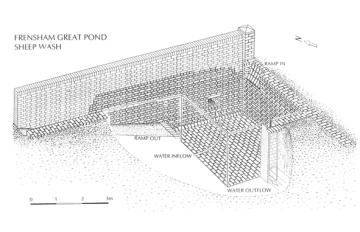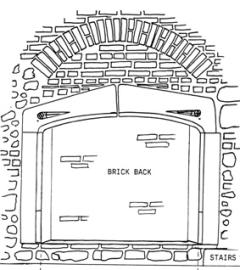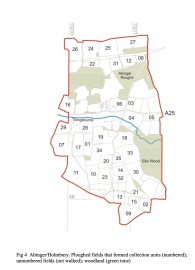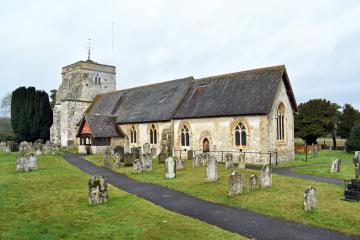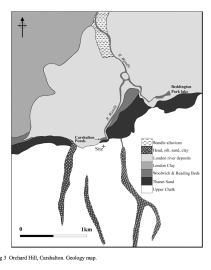Research & Fieldwork Reports - by date of work
The articles below record research and fieldwork undertaken by the Society. Many have not been published elsewhere. Click on the item header or the 'Read more' link to read the complete article. The articles are arranged in descending order of the work done, NOT the date of publication.
Frensham Great Pond sheep wash, 1994
Report by A and D Graham of a sheep wash set into the dam at the outflow of Frensham Great Pond, probably constructed shortly after the commons were enclosed in 1851. (286)
Farnham Castle fireplace discovery, 1991
Recording by D Graham of SyAS of a fireplace of probable 16th century exposed during building works.
Landscape investigation on the Surrey greensand - Abinger & Holmbury 1989
A programme of fieldwalking and woodland inspection carried out between 1985 and 1989 shed light on the changing pattern of settlement and land-use within the Tillingbourne valley.
The attached pdf is a full report of this work of which a paper is published in Vol 101 of the Surrey Archaeological Society Collections.
Frensham Church burial vault, 1987
A 19th century burial vault was discovered in the churchyard in August 1987 when a section of pathway collapsed leaving a 1m-wide circular hole. Members of the local archaeological group, led by D Graham of SyAS, were allowed to record the vault before it was backfilled with sand to render it safe.
Excavations at Guildford Park Manor 1972-5
Archaeological investigations carried out at the moated site of the Royal Manor House of Guildford Park (SU 9691 4931) from1972 to 1975 are described. The site, which has no significant standing buildings, forms part of the garden of Manor Farm and is owned by the University of Surrey. Geophysical surveys, other surveys, historical records and discussions with the tenant farmer were used to decide on the relatively small parts of the site that would be most convenient and valuable to investigate.
Excavation at 12 Bridge Square, Farnham 1971
During October 1971, a limited excavation was carried out beneath the floor of one of the rooms of this old timber frame house in an effort to establish the date of its construction. In this some success was met with, but an added bonus was the discovery of the kitchen area of an earlier, more substantial medieval house. No 12 is the building at the rear of Tanyard House.
For more information please view the attached report.
Excavation at 1 and 2 Church Cottages, Farnham, 1969
No evidence was found of any occupation earlier than 19th century in date and the lack of finds would seem to indicate that there was no settlement in the immediate area.
For more information please view the attached report
Excavation at 17 Red Lion Lane (Bridge Square), Farnham, 1969
Trial trenching inside 17 Red Lion Lane (Brudge Square), Farnham (SU 8411 4652) showed two earlier phases of building: one earlier medieval, one 15th century, underlying the existing cottage.
For more information please view the attached report.
Excavations at Orchard Hill, Carshalton, 1964-5
Excavation by the late Dennis Turner prior to a development close to the parish church in Carshalton recovered worked flint, including an important collection of microliths from the Mesolithic period, and pottery dating from Early Neolithic to the medieval period.
The attached pdf is the full report from which a paper is published in Vol 101 of the Surrey Archaeological Society Collections.
Excavations at Cocks Farm Roman villa, Abinger (2009- present) - interim reports
Between 1995 and 1997 Surrey Archaeological Society carried out excavations under the direction of Steve Dyer to investigate archaeological evidence revealed when a tree blew over at Cocks Farm, Abinger. The presence of a villa had been known since the 1870s when Roman walls were found during the expansion of a kitchen garden . When well-preserved remains of an east-west range of a Roman building were discovered, the fieldwork was targeted to provide information for the future management of the site and to indicate a suitable area for scheduling as an ancient monument.

